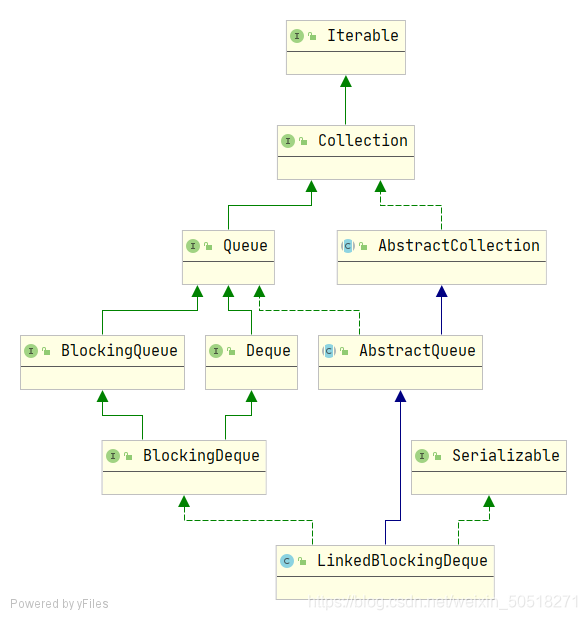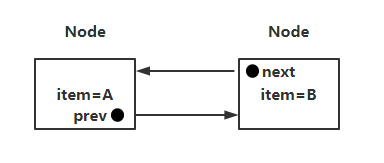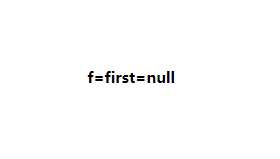关键词:BlockingDeque? ??LinkedBlockingDeque? ??Deque?
JDK中对BlockingDeque的实现,只提供了LinkedBlockingDeque基于链表的实现方式。个人的猜测是因为双端队列基于数组实现的话会比较复杂,数组不适合作为双端队列的实现结构。(学习LinkedBlockingDeque前,建议先了解BlockingDeque,请戳《JUC之BlockingDeque双端队列》)
█?LinkedBlockingDeque


字段:
transient Node<E> first;
transient Node<E> last;
private transient int count;
private final int capacity;
final ReentrantLock lock = new ReentrantLock();
private final Condition notEmpty = lock.newCondition();
private final Condition notFull = lock.newCondition();- first
队列中的第一个元素节点,即队首的第一个元素节点。
Node类型的字段,Node是LinkedBlockingDeque中定义的内部类,从定义来看,Node构成的链表是双向链表。
static final class Node<E> {
// 节点对应的元素
E item;
// 该节点的前驱节点
Node<E> prev;
// 该节点的后驱节点
Node<E> next;
Node(E x) {
item = x;
}
}
- last
队列中的最后一个元素节点,即队尾的第一个元素节点。
- count
队列中存在的元素个数。
- capacity
队列的容量,即队列最多能存放的元素个数。
- lock
使用ReentrantLock来保证线程安全。
- notEmpty
使用ReentrantLock的Condition完成线程间的通信,通知正在阻塞等待移出数据的线程,队列不为空了。
- notFull
通知正在阻塞等待添加数据的线程,队列没有满。
构造器:
public LinkedBlockingDeque() {
this(Integer.MAX_VALUE);
}public LinkedBlockingDeque(int capacity) {
if (capacity <= 0) throw new IllegalArgumentException();
this.capacity = capacity;
}public LinkedBlockingDeque(Collection<? extends E> c) {
this(Integer.MAX_VALUE);
final ReentrantLock lock = this.lock;
lock.lock(); // Never contended, but necessary for visibility
try {
for (E e : c) {
if (e == null)
throw new NullPointerException();
if (!linkLast(new Node<E>(e)))
throw new IllegalStateException("Deque full");
}
} finally {
lock.unlock();
}
}①在构造器中对队列的容量进行初始化,且容量值必须为大于0的正数。
②默认的容量为Integer.MAX_VALUE。
③当使用Collection初始化队列时,集合中不能含有null元素而且集合中元素的个数不能超过队列的容量,即Integer.MAX_VALUE。
方法:
(方法都是对BlockingDeque或Deque中定义的方法的实现,关于方法具体具有的行为约束,请戳《JUC之BlockingDeque双端队列》)
1、向队列中添加元素(不具有阻塞等待功能)
- offerFirst
向队首添加元素,如果队列满了没有足够的空间继续添加元素,则元素添加失败,返回false。
public boolean offerFirst(E e) {
// 限制元素不能为null
if (e == null) throw new NullPointerException();
// 将元素封装成Node对象
Node<E> node = new Node<E>(e);
final ReentrantLock lock = this.lock;
lock.lock();
try {
return linkFirst(node);
} finally {
lock.unlock();
}
}linkFirst:
将first指向新添加的元素节点,新元素节点的next指向原来链表的第一个元素节点,该原来链表的第一个元素节点的prev指向该新元素节点,以此形成新的链表。linkFirst永远将元素节点链接到链表的头节点。(不同于其他基于链表方式实现的类,如LinkedList、AQS中的等待队列。他们在实现链表的时候,链表的第一个节点一直是空的节点,即不存放元素的节点,而LinkedBlockingDeque显然不是)
private boolean linkFirst(Node<E> node) {
// count为队列中元素的个数,capacity为队列的容量
if (count >= capacity)
return false;
// f为原先的队首节点
Node<E> f = first;
// 新节点的next指针指向原先的队首节点
node.next = f;
// 队首指针指向新节点,即将新节点作为队首节点
first = node;
// last==null,即队列中没有元素,这是向队列中添加的第一个元素
if (last == null)
last = node;
// 将原先的队首节点前驱指针指向新的队首节点,
// 这样新的队首节点就与链表链接上了
else
f.prev = node;
// 标记队列中元素的数量的值+1
++count;
// 通知正在等待阻塞从队列中移出值的线程
notEmpty.signal();
return true;
}(1)向空的队列第一次添加元素,此时first、last都为null。
①Node<E> f = first;

②node.next = f;

③first = node;

④last = node;

(2)向已有元素的队列中添加,此时first、last都不为null。
①Node<E> f = first;

②node.next = f;

③first = node;

④f.prev = node

- offerLast
向队尾添加元素,如果队列满了没有足够的空间继续添加元素,则元素添加失败,返回false。
public boolean offerLast(E e) {
if (e == null) throw new NullPointerException();
Node<E> node = new Node<E>(e);
final ReentrantLock lock = this.lock;
lock.lock();
try {
return linkLast(node);
} finally {
lock.unlock();
}
}linkLast:
与linkFirst不同的地方就在于,linkLast是将last指针指向新的元素节点。新的元素节点是一直向链表的尾部添加。
private boolean linkLast(Node<E> node) {
// assert lock.isHeldByCurrentThread();
if (count >= capacity)
return false;
Node<E> l = last;
node.prev = l;
last = node;
if (first == null)
first = node;
else
l.next = node;
++count;
notEmpty.signal();
return true;
}- addFirst
向队首添加元素,如果队列满了,则抛出new IllegalStateException("Deque full")异常。addFirst的实现借助了offerFirst。
public void addFirst(E e) {
if (!offerFirst(e))
throw new IllegalStateException("Deque full");
}- addLast
向队尾添加元素,如果队列满了,则抛出new IllegalStateException("Deque full")异常。addLast的实现借助了offerLast。
public void addLast(E e) {
if (!offerLast(e))
throw new IllegalStateException("Deque full");
}- offer
向队尾添加元素,等价于offerLast(从其实现代码可以看出,是直接调用了offerLast)。
public boolean offer(E e) {
return offerLast(e);
}- add
向队尾添加元素,等价于addLast。如果队列满了无法继续添加元素,则addLast会抛出异常,add会继续将异常抛出。
public boolean add(E e) {
addLast(e);
return true;
}- push
向队首添加元素。等价于addFirst。
public void push(E e) {
addFirst(e);
}2、移出队列中的元素(不具有阻塞等待功能)
- pollFirst
移出队首的第一个元素,如果队列为空,则返回null。
public E pollFirst() {
final ReentrantLock lock = this.lock;
lock.lock();
try {
return unlinkFirst();
} finally {
lock.unlock();
}
}unlinkFirst:
将first指向的元素节点与链表断开连接并返回,然后将first指向原先队首的第二个元素节点,让该元素节点称为新的队首第一个元素节点。
private E unlinkFirst() {
Node<E> f = first;
// f==null表示此时队列为空
if (f == null)
return null;
// n为队首的第二个元素
Node<E> n = f.next;
// 经过下面三行代码,会将队首的第一个元素从链表断开
E item = f.item;
f.item = null;
f.next = f;
// first指向原来队首的第二个元素
first = n;
if (n == null)
last = null;
else
n.prev = null;
--count;
notFull.signal();
return item;
}- pollLast
移出队尾的第一个元素。如果队列为空,则返回null。
public E pollLast() {
final ReentrantLock lock = this.lock;
lock.lock();
try {
return unlinkLast();
} finally {
lock.unlock();
}
}unlinkLast:
将last指向的元素节点与链表断开连接并返回,然后将last指向原先队尾的第二个元素节点,让该元素节点称为新的队尾第一个元素节点。
private E unlinkLast() {
// assert lock.isHeldByCurrentThread();
Node<E> l = last;
if (l == null)
return null;
Node<E> p = l.prev;
E item = l.item;
l.item = null;
l.prev = l; // help GC
last = p;
if (p == null)
first = null;
else
p.next = null;
--count;
notFull.signal();
return item;
}- removeFirst
移出队首的第一个元素,如果队列为空,则抛出NoSuchElementException异常。removeFirst的实现借助了pollFirst。
public E removeFirst() {
E x = pollFirst();
if (x == null) throw new NoSuchElementException();
return x;
}- removeLast
移出队尾的第一个元素,如果队列为空,则抛出NoSuchElementException异常。
public E removeLast() {
E x = pollLast();
if (x == null) throw new NoSuchElementException();
return x;
}- poll
移出队首的第一个元素,等价于pollFirst。
public E poll() {
return pollFirst();
}- remove
移出队首的第一个元素,等价于removeFirst。
public E remove() {
return removeFirst();
}- pop
等价于removeFirst。
public E pop() {
return removeFirst();
}3、查看队首、队尾元素
- peekFirst
获取队首的第一个元素,如果队列为空,则返回null。该方法只查看却不移出元素。
public E peekFirst() {
final ReentrantLock lock = this.lock;
lock.lock();
try {
return (first == null) ? null : first.item;
} finally {
lock.unlock();
}
}- peekLast
获取队尾的第一个元素,如果队列为空,则返回null。该方法只查看却不移出元素。
public E peekLast() {
final ReentrantLock lock = this.lock;
lock.lock();
try {
return (last == null) ? null : last.item;
} finally {
lock.unlock();
}
}- getFirst
获取队首的第一个元素,如果队列为空,则抛出NoSuchElementException异常。
public E getFirst() {
E x = peekFirst();
if (x == null) throw new NoSuchElementException();
return x;
}- getLast
获取队尾的第一个元素,如果队列为空,则抛出NoSuchElementException异常。
public E getLast() {
E x = peekLast();
if (x == null) throw new NoSuchElementException();
return x;
}- peek
获取队首的第一个元素,等价于peekFirst。
public E peek() {
return peekFirst();
}- element
获取队首的第一个元素,如果队列为空,则抛出NoSuchElementException异常。
public E element() {
return getFirst();
}?getFirst:
public E getFirst() {
E x = peekFirst();
if (x == null) throw new NoSuchElementException();
return x;
}4、向队列中添加元素(具有阻塞等待功能)
- putFirst
向队首添加元素,当队列满了无法继续添加元素时,该方法会一直阻塞,直到队列有空间可以添加该元素了。while (!linkFirst(node)) notFull.await();使用while循环去调用linkFirst尝试向队首添加元素,如果添加失败就调用notFull.await()让当前线程休眠。直到其他线程调用了从队列中移出元素时,会调用notFull.signal()方法唤醒该线程,继续尝试添加元素到队首。
public void putFirst(E e) throws InterruptedException {
if (e == null) throw new NullPointerException();
// 将元素封装成Node对象
Node<E> node = new Node<E>(e);
final ReentrantLock lock = this.lock;
lock.lock();
try {
while (!linkFirst(node))
notFull.await();
} finally {
lock.unlock();
}
}- putLast
和putFirst相似,不同的是向队尾添加元素。
public void putLast(E e) throws InterruptedException {
if (e == null) throw new NullPointerException();
Node<E> node = new Node<E>(e);
final ReentrantLock lock = this.lock;
lock.lock();
try {
while (!linkLast(node))
notFull.await();
} finally {
lock.unlock();
}
}- offerFirst
具有超时阻塞等待的向队首添加元素。在达到超时等待时长时,如果还没有添加元素成功,则返回false。
public boolean offerFirst(E e, long timeout, TimeUnit unit)
throws InterruptedException {
if (e == null) throw new NullPointerException();
Node<E> node = new Node<E>(e);
long nanos = unit.toNanos(timeout);
final ReentrantLock lock = this.lock;
lock.lockInterruptibly();
try {
while (!linkFirst(node)) {
if (nanos <= 0)
return false;
nanos = notFull.awaitNanos(nanos);
}
return true;
} finally {
lock.unlock();
}
}- offerLast
与offerFirst相似,不同的是其是向队尾添加元素。
public boolean offerLast(E e, long timeout, TimeUnit unit)
throws InterruptedException {
if (e == null) throw new NullPointerException();
Node<E> node = new Node<E>(e);
long nanos = unit.toNanos(timeout);
final ReentrantLock lock = this.lock;
lock.lockInterruptibly();
try {
while (!linkLast(node)) {
if (nanos <= 0)
return false;
nanos = notFull.awaitNanos(nanos);
}
return true;
} finally {
lock.unlock();
}
}- put
等价于putLast。
public void put(E e) throws InterruptedException {
putLast(e);
}- offer
等价于offerLast。
5、从队列中移出元素(具有阻塞等待功能)
- takeFirst
移出队首的第一个元素,如果元素为空,则会一直阻塞等待,直到队首有元素可以移出。
public E takeFirst() throws InterruptedException {
final ReentrantLock lock = this.lock;
lock.lock();
try {
E x;
while ( (x = unlinkFirst()) == null)
notEmpty.await();
return x;
} finally {
lock.unlock();
}
}- takeLast
与takeFirst相似,不同在于其是移出队尾的第一个元素。
public E takeLast() throws InterruptedException {
final ReentrantLock lock = this.lock;
lock.lock();
try {
E x;
while ( (x = unlinkLast()) == null)
notEmpty.await();
return x;
} finally {
lock.unlock();
}
}- pollFirst
具有超时阻塞等待的从队首移出第一个元素,如果超过了阻塞等待时长,队列还为空,则返回null。
public E pollFirst(long timeout, TimeUnit unit)
throws InterruptedException {
long nanos = unit.toNanos(timeout);
final ReentrantLock lock = this.lock;
lock.lockInterruptibly();
try {
E x;
while ( (x = unlinkFirst()) == null) {
if (nanos <= 0)
return null;
nanos = notEmpty.awaitNanos(nanos);
}
return x;
} finally {
lock.unlock();
}
}- pollLast
与pollFirst相似,不同的是其是移出队尾的第一个元素。
public E pollLast(long timeout, TimeUnit unit)
throws InterruptedException {
long nanos = unit.toNanos(timeout);
final ReentrantLock lock = this.lock;
lock.lockInterruptibly();
try {
E x;
while ( (x = unlinkLast()) == null) {
if (nanos <= 0)
return null;
nanos = notEmpty.awaitNanos(nanos);
}
return x;
} finally {
lock.unlock();
}
}- take
等价于takeFirst。
public E take() throws InterruptedException {
return takeFirst();
}6、其他方法
- removeFirstOccurrence
从队首遍历,移出第一个与指定元素匹配的队列元素。
public boolean removeFirstOccurrence(Object o) {
if (o == null) return false;
final ReentrantLock lock = this.lock;
lock.lock();
try {
// 从队首开始遍历
for (Node<E> p = first; p != null; p = p.next) {
// 使用equals匹配
if (o.equals(p.item)) {
unlink(p);
return true;
}
}
return false;
} finally {
lock.unlock();
}
}- removeLastOccurrence
从队尾遍历,移出第一个与指定元素匹配的队列元素。
public boolean removeLastOccurrence(Object o) {
if (o == null) return false;
final ReentrantLock lock = this.lock;
lock.lock();
try {
for (Node<E> p = last; p != null; p = p.prev) {
if (o.equals(p.item)) {
unlink(p);
return true;
}
}
return false;
} finally {
lock.unlock();
}
}- remove
等价于removeFirstOccurrence。
public boolean remove(Object o) {
return removeFirstOccurrence(o);
}- contains
查看队列中是否存在指定的元素。
public boolean contains(Object o) {
if (o == null) return false;
final ReentrantLock lock = this.lock;
lock.lock();
try {
for (Node<E> p = first; p != null; p = p.next)
if (o.equals(p.item))
return true;
return false;
} finally {
lock.unlock();
}
}- size
获取队列中元素的个数。
public int size() {
final ReentrantLock lock = this.lock;
lock.lock();
try {
return count;
} finally {
lock.unlock();
}
}